And now to the box itself and reasons as to why some are not efficient. These next illustrations refer to the second stage of the box where we are attempting to process ammonia-rich water after the first mechanical stage has been employed.
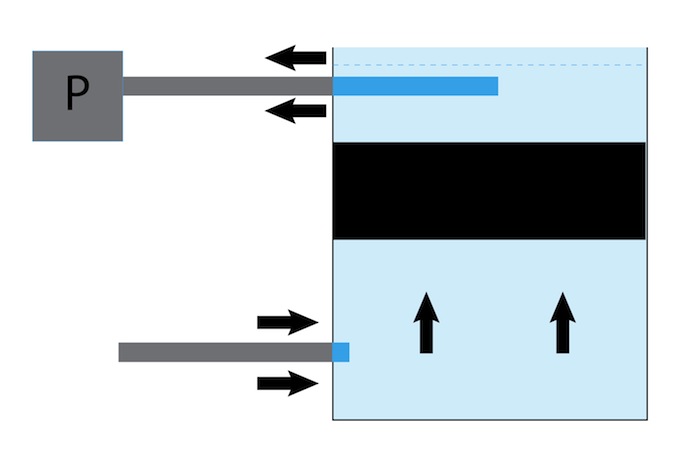 1. This shows incoming water from the drain rising as it should by natural ‘level’ which is perfect to pass dissolved toxins through all surfaces of the black media shown. This is exactly what is required to service all surfaces. But the perfect distribution only takes place on the very first fill.
1. This shows incoming water from the drain rising as it should by natural ‘level’ which is perfect to pass dissolved toxins through all surfaces of the black media shown. This is exactly what is required to service all surfaces. But the perfect distribution only takes place on the very first fill.
 1a. The problem here is that, when the pump taking exit water from the centre of the box is turned on, the incoming water (with impetus) is attracted to the central pump suction intake which results in this same water tracking directly to the exit pick-up. As a result only 20% or so of the media surfaces will be presented with a distribution of incoming water. In short, a flawed idea.
1a. The problem here is that, when the pump taking exit water from the centre of the box is turned on, the incoming water (with impetus) is attracted to the central pump suction intake which results in this same water tracking directly to the exit pick-up. As a result only 20% or so of the media surfaces will be presented with a distribution of incoming water. In short, a flawed idea.
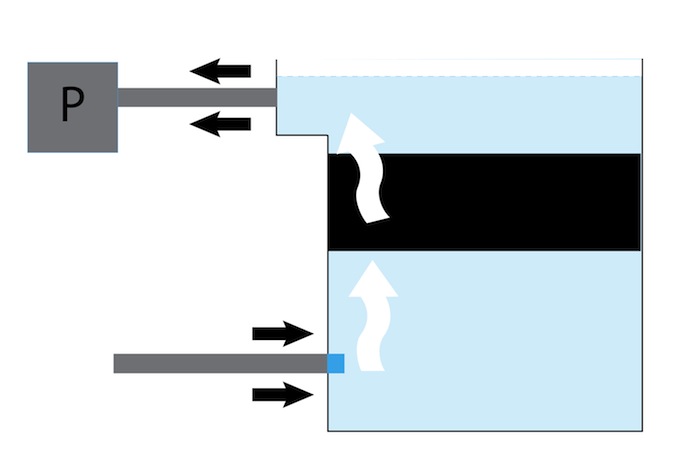 2. Some boxes have side off-takes and, irrespective of where in the box the water enters, once the pump is brought into the picture the water tracks to the suction inlet. This results once again in inefficiency of the media bed inside no matter how it is operated – solid block or moving bed because the water flow avoids most of it. Again, only 20% of the surfaces will be provided for.
2. Some boxes have side off-takes and, irrespective of where in the box the water enters, once the pump is brought into the picture the water tracks to the suction inlet. This results once again in inefficiency of the media bed inside no matter how it is operated – solid block or moving bed because the water flow avoids most of it. Again, only 20% of the surfaces will be provided for.
There have been many ideas put forward as to how best to take water from the surface of boxes and these range from complex ‘spider’s web’ assemblies drilled at particular points like the old under gravel filter assembly reversed. As expected this is only marginally better. There have been cross assemblies; ‘elephant trunk’ off-takes and several others but none have been even mildly worth pursuing.
 3. Whilst I would never recommend this method, it is the best I know of where some kind of distribution can be achieved. By cutting down the inner box EXACTLY LEVEL to one inch or so below actual running level of the pond and building a catchment tray below it on the outside of the box AND providing the box itself is positioned EXACTLY LEVEL; a waterfall effect will be produced on all the edges of the inner box and this will fall into the catchment tray below. A pump pick-up can be taken then from any part of the catchment tray and water will continue to rise perfectly upwards through the inner box itself. Apart from this being a pretty ‘hit and miss’ situation, whereby the pump has to be set to perfection and avoid any fluctuations in order to prevent either starvation or complete overflow, the rising water will also ‘track’ as usual to all the edges of the inner box and, as a result, only 30% of the surfaces will be supplied correctly. Again, despite the complexities involved in building and controlling this method I feel simplicity should come to our assistance here.
3. Whilst I would never recommend this method, it is the best I know of where some kind of distribution can be achieved. By cutting down the inner box EXACTLY LEVEL to one inch or so below actual running level of the pond and building a catchment tray below it on the outside of the box AND providing the box itself is positioned EXACTLY LEVEL; a waterfall effect will be produced on all the edges of the inner box and this will fall into the catchment tray below. A pump pick-up can be taken then from any part of the catchment tray and water will continue to rise perfectly upwards through the inner box itself. Apart from this being a pretty ‘hit and miss’ situation, whereby the pump has to be set to perfection and avoid any fluctuations in order to prevent either starvation or complete overflow, the rising water will also ‘track’ as usual to all the edges of the inner box and, as a result, only 30% of the surfaces will be supplied correctly. Again, despite the complexities involved in building and controlling this method I feel simplicity should come to our assistance here.
In all the above examples and despite the actual size of the boxes, it should be apparent that attempts to clean these thoroughly as necessary is more than just a chore because, unless a pressure washer is on hand and the box is emptied first of all contents – well, it’s nothing short of a nightmare.
Here is my suggestion for a box/lavatory – it is only the box showing no contents, just the discharge operation without flow-patterns. If this looks the epitome of simplicity – it is just that; a long flat-bottomed box with a partial division and there are no hi-tech innovations here. However, every single inch of the box has been well thought out beforehand.
Water enters the box from the bottom drain and into the ‘lavatory’ section first stage, it then passes through to the open letterbox transfer aperture and into the second stage where it is picked up by the pump and passed back to the pond. The only point not made clear is that the three sockets built into the base of the unit are finished slightly below the level of the flat base. This is to ensure that both the entire boxes are completely empty of water when discharged. I have purposely shown what happens in the second stage when the box is devoid of aeration and filter media. The water merely ‘tracks’ to the pumps along the centre level of water depth and this is of no use at all.
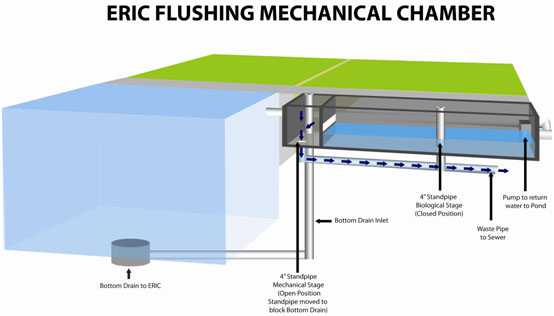 By stopping the pump, removing the first standpipe then placing it immediately to stop any incoming water to the box from the drain. The entire lavatory empties to waste as suggested by Mr. Crapper. At the same time, half of the second stage rushes back towards the same drainage outlet. In doing so it also provides the necessary current to backwash the horizontal brush barrier when in position inside the first box.
By stopping the pump, removing the first standpipe then placing it immediately to stop any incoming water to the box from the drain. The entire lavatory empties to waste as suggested by Mr. Crapper. At the same time, half of the second stage rushes back towards the same drainage outlet. In doing so it also provides the necessary current to backwash the horizontal brush barrier when in position inside the first box.
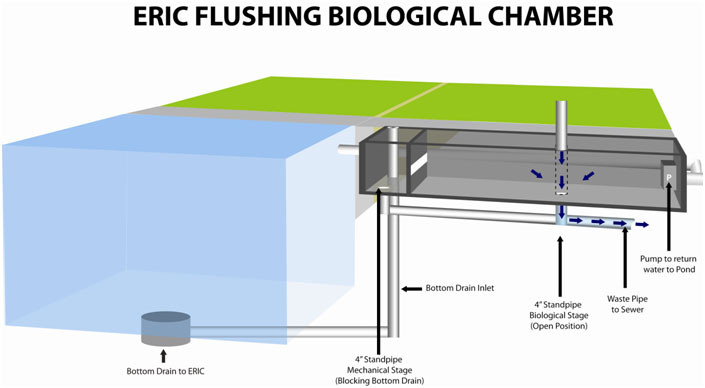 The second stage standpipe is now removed and thus the entire box is empty and all unwanted detritus has been removed to sewer leaving the box as good as new. This is of paramount importance in the quest for ‘Koi Water’ mentioned earlier.
The second stage standpipe is now removed and thus the entire box is empty and all unwanted detritus has been removed to sewer leaving the box as good as new. This is of paramount importance in the quest for ‘Koi Water’ mentioned earlier.
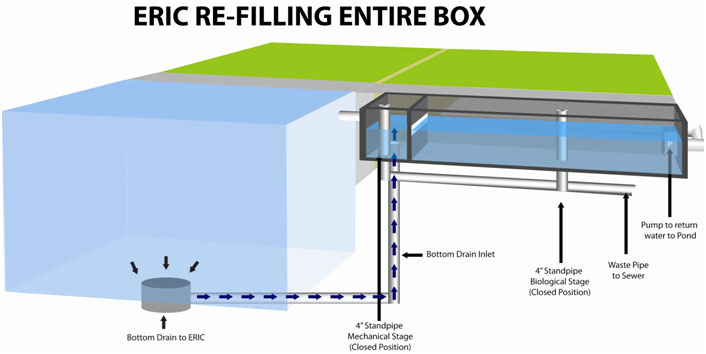 By simply replacing the two standpipes into their normal positions, the box is quickly refilled by incoming water entering from the bottom drain. It is obvious that the box also has its own built-in drain line purge assembly if required and by drilling the main sewer outlet standpipe at water level with 0.25” holes this serves as a perfect system overflow.
By simply replacing the two standpipes into their normal positions, the box is quickly refilled by incoming water entering from the bottom drain. It is obvious that the box also has its own built-in drain line purge assembly if required and by drilling the main sewer outlet standpipe at water level with 0.25” holes this serves as a perfect system overflow.
Furthermore, as most ‘proper’ ponds are built ‘in-ground’ for maximum aesthetic benefits by way of good landscaping, that is all we see after the system is finished. There are no underground boxes required with access ladders to service underground valves etc. All it takes to carry out a discharge (flush) is to bend over and lift standpipes. The greatest benefit however is that after a full discharge has been made, the water discharged to sewer produces a level drop in the average pond which is less than 20mm, this allows the system to be started up again immediately. The entire operation of total discharge from ‘pump off’ to ‘pump on’ is slightly less than 3 minutes and this can be carried out by almost anyone after an initial demonstration.
Again, these illustrations are only to detail what I consider to be the perfect ‘no-nonsense’ filter box as of right now with recognition, respect and enormous thanks to the late Mr. Thomas Crapper.
Full operational details of ERIC and performance principles will be covered on another page of this website.




